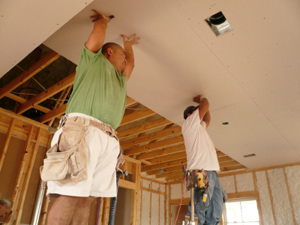October 26, 2009
More On Chinese Drywall

By Michael D. Shaw
We got good reaction to last week’s introductory piece on Chinese drywall, so it seemed appropriate to follow it up with some recent developments.
People in this field should first consider bringing in some new terminology. What if a home is showing the classic symptoms of Chinese drywall—that is, a “rotten egg” smell; residents exhibiting several health symptoms while in the home; corrosion or blackening of certain metal items; and failures of copper piping in air conditioning units—but the drywall installed in the home is of domestic origin? In fact. there are at least two well-documented cases of this occurring.
Moreover, not all drywall from China is problematical, and within the bad Chinese material there are varying levels of damage produced. Perhaps a better term would be “tainted drywall.”
An accepted method for drywall evaluation takes advantage of a peculiar property of at least the tainted Chinese board: Its strontium content is much higher than what is present in non-tainted drywall. Thus, the technique of x-ray fluorescence (XRF), which gives an elemental breakdown of materials, can be utilized to quickly scan a piece of drywall.
However, this method has two disadvantages. A portable XRF unit is expensive, and even though high strontium content correlates well with tainted drywall, this test focuses on a marker for the problem, rather than on the actual problem itself (sulfide-emitting drywall). One might also ask, “Why does the board emit sulfide gases in the first place?”
Three sulfide gases have been identified as the culprits here: Hydrogen sulfide (famous as the “rotten egg” smell), carbon disulfide, and carbonyl sulfide. Some people can smell hydrogen sulfide at levels as low as 0.5 parts-per-billion [ppb], which is a much lower concentration than anyone has implicated in health effects. As such, a tainted drywall house could be effectively remediated to some mandated concentration (for example 20 ppb—established as the so-called Minimal Risk Level) but still retain an odor perceptible to certain individuals.
But what is the source of these sulfides?
Gypsum is hydrated calcium sulfate, and there have been suggestions that the hot and humid conditions of Florida and other affected states somehow trigger chemical reactions, whereby the three sulfides could be produced. Eminent chemist Dr. Gilbert Gordon notes that, “To my knowledge, no thermodynamically acceptable and kinetically feasible chemical model has been suggested. This does seem to rule out the possibility of the chemical formation of the foul smelling volatile compounds [i.e. the sulfides mentioned above].”
If a chemical formation process is ruled out, what does that leave us? How about the metabolic activity of microorganisms. Certainly, the formation of these sulfide compounds by such mechanisms is well-documented, and drywall has been shown to contain sufficient organic materials to promote bacterial metabolism. I got further information from John Mason of Sabre Environmental Services LLC.
Mason says that when drywall samples are cultured, the tainted drywall shows as much as 10,000 times more of the sulfate reducing bacteria than normal drywall. Based on these results, Mason believes that a relatively simple bacterial test could be used to confirm the presence of tainted drywall in a residence. In fact, he has done this in the field.
As to remediating a tainted drywall house, Mason draws on his company’s experience in getting rid of anthrax in numerous government buildings. For anthrax, the chemical chlorine dioxide was applied to the buildings, and proved to be remarkably effective in killing the organism. Another excellent property of chlorine dioxide is that it reacts quickly to remove sulfides.
Sabre tried this approach on a home in Cape Coral, Florida several months ago, with excellent results. A number of other homes have been treated, as well. In the Cape Coral house, Sabre employees found a Chinese manufacturer’s label on sheets of drywall in the attic. After testing the samples, technicians determined that abnormal levels of bacteria were present in the back paper of the drywall.
What about tainted drywall of domestic origin? Chemists and engineers are working the problem, but one possibility is that formerly good drywall can absorb sulfide gases emitted by tainted product. This can occur in a warehouse, or after installation. It is less likely that bacteria from a tainted board could infect a non-tainted board, but bacteria are notorious for doing the unexpected.
While the bulk of the tainted drywall issue focuses on homes affected by product that was used in original construction, many contractors in Florida are taking extra precautions when purchasing even small amounts of drywall, to be used for repairs or remodeling. What homeowner would want to ruin a previously unaffected residence?
All the more reason for a standardized testing protocol to be developed as soon as possible.

